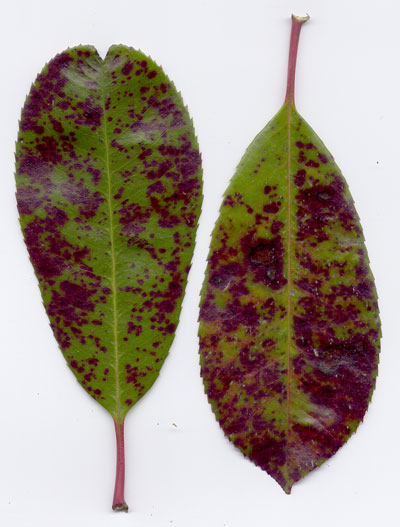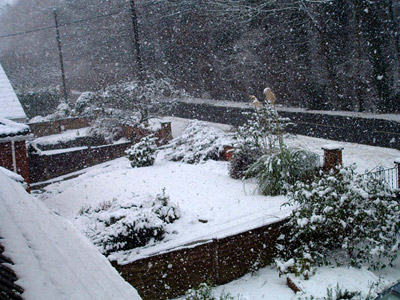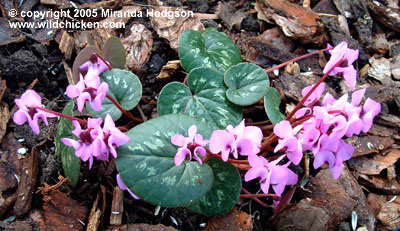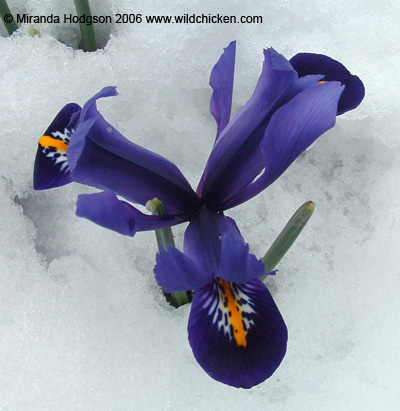January 14th 2006 - Bacterial infection on Photinia?
So, another year already under way. I canít quite figure out where last year went, it all happened so quickly and now weíre suddenly half way through January. Iím sure that time is speeding up. Or maybe itís an age thing.
Looking at the plants, nothing appears to have succumbed from the recent cold spell, but there is what could be a bacterial infection on the Photinia x fraseri 'Red Robin'. Iíd noticed a few spots on it late last year, but now some of the leaves are speckled with splotches, with black specks in the centre. I hope it isnít the dreaded fungus, Entomosporium maculatum, - which not unlike the bacterial leaf spot - but all the pictures that Iíve looked suggest that itís more likely to be bacterial.

Please say it isn't Entomosporium maculatum!
What to do? To start with, Iíll remove all the affected leaves, and any that have dropped, to stop it spreading more. Once the weather warms up a bit, Iíll prune it right back and give it a good feed. After that itís fingers crossed. Weíve had some cold damp weather (the gloomiest January for ten years, according to the Met Office; no wonder my hibernation urges have been so strong) which will have been ideal for the problem to get going.
"There isnít a lot to be done if the plants have wet leaves for long periods, other than wipe off every leaf every time it rains"
There isnít a lot to be done if the plants have wet leaves for long periods, other than wipe off every leaf every time it rains, so Iíll just have to pay attention and make sure the plants are kept in as good health as possible so they can resist infection.
Iíve wondered if this garden gets as much ventilation as the neighbouring ones. Weíre a fair bit more below street level than the people on either side, because they had their gardens raised almost to street level many years ago, by importing a great deal of soil. A fair bit of ours is about six feet below street level; not sure how much difference that makes, but Iíll be keeping my eyes open from now on.
We had a good layer of snow over New Year, which was lovely to look out on. It lingered for a few days, gradually thawing and leaving the garden somewhat soggy. Better than a downpour, which would have run off the top of the soil rather than soaking in.

Snowy morning in Broughton
On the RHS course, we were given a tip for finding the warmest part of the garden, which is easiest to discover when there is snow on the ground. Itís so in-yer-face obvious, once you know, and is one of those things that you canít quite understand why you didnít work it out for yourself - itís the area where the snow melts first.
Our warmest area is tiny, a tight little corner against a south-facing wall where there is currently an Elaeagnus x ebbingei 'Limelight' with a large Euphorbia mellifera on one side and an unknown rose on the other (one of the few plants in the garden when we moved here). The Euphorbia doesnít need to be in such a sheltered spot, so its spot can taken by Euphorbia characias ĎPortuguese Velvet', as it isnít fully hardy and may benefit from that extra bit of warmth and shelter. E. ĎPortuguese Velvetí spreads outwards into a big dome, while E. mellifera is more upright with long stems, so if they change places, it will mean removing more lawn so the bed can be enlarged. I was planning to dig more up anyway, so itís just as well. Have to wonder if weíll still have any lawn left in a few years, the way things are going.
"The leaves of Bergenia ĎAdmiralí have turned dark red with cold, as they are supposed to do"
The leaves of Bergenia ĎAdmiralí I bought at Beth Chattoís nursery have turned dark red with cold, as they are supposed to do, though theyíre not yet as bright as the lovely specimens in her garden. As we saw them last March, they may develop more in the next couple of months. Itís supposed to be one of the best cultivars for winter foliage colour so I have high hopes for it.
The area under the apple tree, which I planted up with Cyclamen coum and Galanthus nivalis (common snowdrops) is looking good. The patch of Cyclamen has grown and there are a lot more little pink nodding flowers this year. The same with the snowdrops Ė I put in five groups of bulbs, planted in the green Ė there are fat clumps of flower buds pushing up through the layer of bark, lots more than before, so we should have a lovely display soon.

Gently investigating under a leaf mould mulch, the first pointed pink shoots of Dicentra spectabilis are emerging. This is a wonderful plant for chilly climates and, whilst it looks tender, is reputed to be hardy down to at least Ė20c.
Almost makes you feel that spring canít be far away, doesnít it? Until I spot the shoots and still tightly furled buds of Iris reticulata 'Harmony' and recall that, last year they were flowering through three inches of snow. There are at least two months of chilly weather to come and not a great deal will be going on till then, but at least we have these winter flowers to brighten things till then.

© Copyright Miranda Hodgson 2006